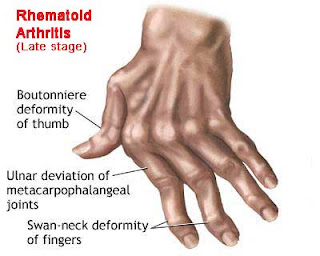
The goal of treatment is twofold: alleviating the current symptoms, and preventing the future destruction of the joints with the resulting handicap if the disease is left unchecked. These two goals may not always coincide: while pain relievers may achieve the first goal, they do not have any impact on the long-term consequences. For these reasons, the ACR recommends that RA should generally be treated with at least one specific anti-rheumatic medication, also named DMARD (see below), to which other medications may be added depending on how long a person has had RA, how active the disease is, and prognostic factors (such as X-ray evidence of bone erosion; elevation of blood factors such as Rheumatoid factor, anti-cyclic citrullinated peptide, C-reactive protein, and erythrocyte sedimentation rate; age and gender; physical functioning; and smoking, for example).
Cortisone therapy has offered relief in the past, but its long-term effects have been deemed undesirable. However, cortisone injections can be valuable adjuncts to a long-term treatment plan, and using low dosages of daily cortisone (e.g., prednisone or prednisolone, 5–7.5 mg daily) can also have an important benefit if added to a proper specific anti-rheumatic treatment.
Pharmacological treatment of RA can be divided into disease-modifying antirheumatic drugs (DMARDs), anti-inflammatory agents and analgesics. Treatment also includes rest and physical activity.wikipedia
